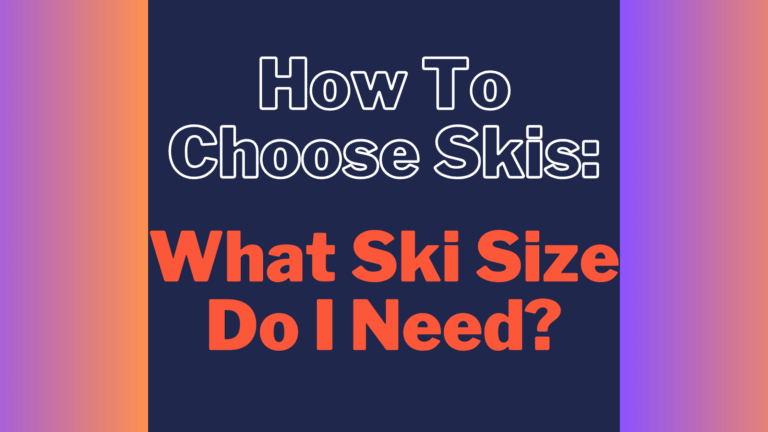Best Ski Helmets of 2024

A ski helmet is an essential part of your ski gear, regardless of your skill level. Modern helmets are lighter and safer, making now the perfect time to upgrade.
I have researched various models in different conditions and consulted ski enthusiasts, to find the best options for warmth, ventilation, comfort, weight, and goggle compatibility. With so many choices available, I simplified the selection process to help you find the ideal helmet that fits your budget, needs, and style.
The top picks for the 2024 season range from high-end models with customizable fits and ventilation to affordable, effective options. You can check the comparison table and the buyer’s guide after the selection to learn more about ski helmets.
Ski Helmet Top Picks
Best Ski Helmet Overall: Smith Vantage Mips
Best Affordable Ski Helmet: Giro Ratio MIPS Helmet
Best for Resort Skiing: Smith Level MIPS
Best for Backcountry Skiing: Salomon MTN Lab
Best for Freeride and Park Skiing: Anon Logan WaveCel
Best for Ski Touring: Atomic Backland CTD
Best Ski Helmet with Integrated Goggles: Salomon Driver Prime Sigma Photo MIPS
Best Ski Helmet Overall
Smith Vantage Mips
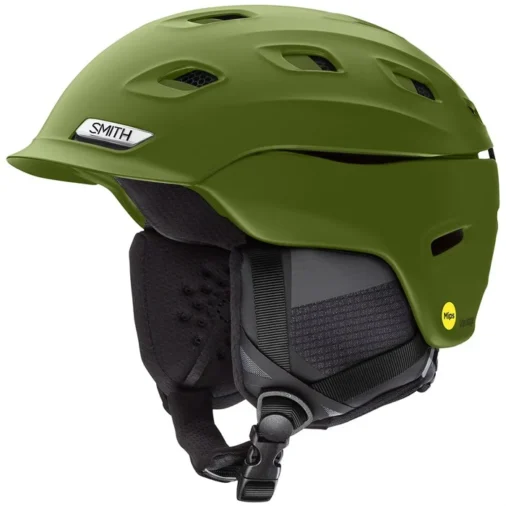
Construction: Hybrid in-mold
Shell Material: Hybrid shell with Zonal KOROYD coverage
Vents: 21 vents
Weight: 500g
Overall Impression: The Smith Vantage MIPS is an exceptional helmet that excels in safety, comfort, and ventilation. If you prioritize top-of-the-line protection, don’t mind the higher price tag, and mostly ski on resorts with occasional forays into the backcountry, this helmet is a fantastic choice.
The Smith Vantage MIPS helmet is a perennial favorite among skiers, consistently topping the charts for its exceptional blend of safety, comfort, and ventilation. Here’s a closer look at what makes this helmet such a standout. The Vantage MIPS boasts a hybrid shell construction that combines a lightweight in-mold shell with a durable hardshell upper section. This design offers the best of both worlds: excellent protection from impacts without unnecessary weight.
When it comes to impact protection, the Smith Vantage MIPS pulls out all the stops. Koroyd® zonal absorption technology, strategically placed throughout the helmet liner, dampens impacts effectively. Additionally, MIPS® technology adds an extra layer of defense against rotational forces in angled falls, a common cause of head injuries on the slopes. Both of these features are hallmarks of top-of-the-line ski helmets.
One of the key factors contributing to the exceptional comfort of the Vantage MIPS is the Boa® 360 fit system. This innovative system features a dial that allows for precise micro-adjustments, ensuring a secure and comfortable fit that eliminates pressure points. Many reviewers rave about the Boa® system’s ease of use and ability to achieve a perfect fit.
Overheating and goggle fogging can quickly ruin a ski day. The Vantage MIPS tackles these issues with its AirEvac 2 ventilation system. Channels and adjustable vents strategically placed throughout the helmet promote airflow, keeping you cool and comfortable. Exceptional ventilation is a consistent theme in customer reviews of the Smith Vantage MIPS.
The Smith Vantage MIPS isn’t all about safety and comfort; it also boasts thoughtful features that enhance the overall user experience. The helmet integrates seamlessly with Smith goggles for a perfect fit and eliminates goggle gaps. The removable ear pads provide comfort and allow for easy audio system compatibility. Not only that, an anti-bacterial lining helps prevent odors and keeps the helmet fresh.
Best Affordable Ski Helmet
Giro Ratio MIPS Helmet
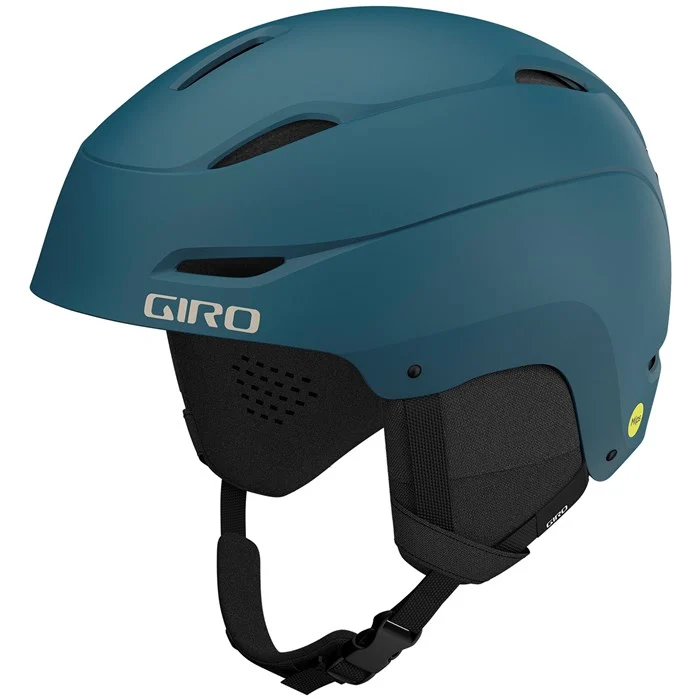
Construction: Hardshell
Shell Material: ABS with EPS foam liner
Vents: 10 Adjustable Vents
Weight: 610g
Overall Impression: The Giro Ratio MIPS is a solid helmet that stands out for its affordability and inclusion of MIPS technology. If you are a recreational or intermediate skier prioritizing proven safety and a comfortable fit on a budget, this helmet should be your top choice.
The Giro Ratio MIPS is a no-nonsense helmet designed to offer essential safety features and comfort at an accessible price point. It’s a fantastic option for recreational skiers and snowboarders who want a reliable helmet without breaking the bank.
At the heart of the Ratio MIPS is its protective technology. The hardshell construction provides a durable barrier against impacts, while the inclusion of MIPS (Multi-Directional Impact Protection System) adds an extra layer of safety by reducing rotational forces that can occur during angled falls. For comfort, the helmet features Giro’s In-Form Fit System. This adjustable system allows you to dial in a snug and comfortable fit that conforms to your head shape. Many users praise the In-Form Fit System for its quick, easy adjustment and comfortable, secure fit.
The Giro Ratio MIPS also includes Thermostat Control adjustable venting, which lets you customize airflow to regulate temperature and prevent goggle fogging. Many appreciate its ability to manage airflow to stay comfortable during changing weather conditions. It’s compatible with aftermarket audio systems from Outdoor Tech so you can enjoy your favorite tunes on the slopes. Overall, this helmet prioritizes protection and functionality, making it a great choice for budget-conscious skiers who demand proven safety on the slopes.
Best for Resort Skiing
Smith Level MIPS
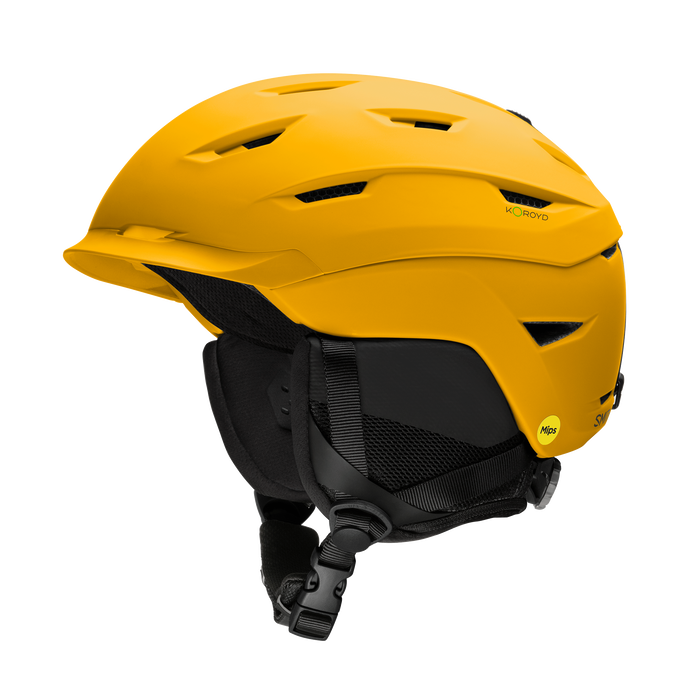
Construction: Hybrid lightweight in mold
Shell Material: ABS hardshell with Zonal KOROYD
Vents: 20
Weight: 550g
Overall Impression: While it might not be the lightest option on the market, the overall build quality and user experience make it a great choice for many skiers.
The Smith Level MIPS is a helmet that strikes a great balance between protection, comfort, and style, making it a popular choice for all-mountain skiers and snowboarders. Its Bombshell construction uses a durable ABS hardshell to provide reliable impact resistance. Additionally, MIPS technology is incorporated to offer that extra layer of safety in reducing rotational forces during angled falls.
Customers rave about the comfort offered by the Smith Level MIPS. The fit is personalized using the VaporFit adjustable system, ensuring a secure but pressure-point-free fit around the head. The plush lining delivers a cozy feel for those long days on the slopes. To stay cool and comfortable, the helmet integrates Smith’s AirEvac 2 ventilation system which pulls air through channels and prevents goggle fogging. Users find this ventilation system very effective in a range of weather conditions.
The Smith Level MIPS doesn’t sacrifice style either. It has a modern, low-profile look with a variety of color options to match your gear preferences. Plus, the earpads are audio-ready for seamless integration of speaker systems if you love to ride with music. It definitely hit the sweet spot for many skiers seeking a comfortable, protective, and well-rounded helmet for their resort adventures.
Best for Backcountry Skiing
Salomon MTN Lab

Construction: In-mold
Shell Material: EPS, Polycarbonate
Vents: 12
Weight: 400g
Overall Impression: If you regularly venture into the backcountry, appreciate breathability, and are willing to invest in specialized gear, the MTN Lab is well worth considering.
For backcountry adventurers who demand both lightweight performance and uncompromising protection, the Salomon MTN Lab helmet stands apart. This helmet utilizes an innovative combination of an ultralight in-mold shell and strategically integrated EPS 4D technology to deliver exceptional impact absorption while minimizing weight. Backcountry skiers rave about how easily this helmet seems to disappear on your head, making long climbs less tiring.
The emphasis on ventilation is undeniable in the Salomon MTN Lab. With 12 big vents strategically placed throughout the helmet create exceptional airflow, keeping you cool during strenuous ascents and minimizing goggle fogging. Users consistently praise its ability to handle temperature variation, from sweaty skin-tracks to chilly descents. Additionally, the helmet boasts dual certifications for both alpine skiing and mountaineering, meaning you can have full confidence in its protective abilities should the unexpected happen in the mountains.
The MTN Lab is designed for no-fuss functionality. The fit system offers secure adjustment, and the Merino wool liner is naturally antibacterial and moisture-wicking, keeping you comfortable all day. Clever additions like headlamp clips and a goggle strap retainer demonstrate attention to detail for backcountry needs. While not the absolute cheapest option for backcountry skiers, the Salomon MTN Lab is an investment in lightweight performance and versatility that serious backcountry enthusiasts will appreciate for many seasons to come.
Best for Freeride and Park Skiing
Anon Logan WaveCel
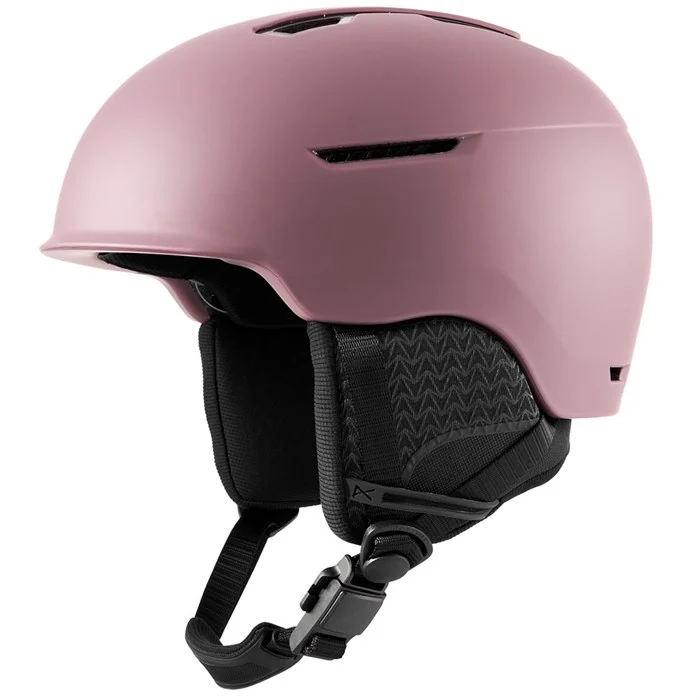
Construction: In-mold
Shell Material: Polycarbonate
Vents: 10
Weight: 424g
Overall Impression: If you’re prone to pushing limits, the added peace of mind offered by WaveCel could be invaluable. However, try it on carefully to ensure the right fit.
The Anon Logan WaveCel helmet redefines head protection by integrating one of the most significant advancements in helmet safety in recent years: WaveCel technology. This collapsible cellular structure lines the inside of the helmet and is designed to flex, crumple, and glide to redirect impact energy, significantly reducing the risk of head injuries. It’s a leap forward in safety that appeals to those who demand the best protection the market offers.
Beyond WaveCel, the Anon Logan boasts a lightweight in-mold construction that prioritizes weight reduction while maintaining excellent impact absorption. Riders prioritizing comfort will find the luxurious liner and earpads ideal for extended wear, ensuring all-day coziness. The integrated ventilation system keeps you cool and prevents overheating during warmer conditions. However, this same feature may lead to a cooler experience during the colder days, something to keep in mind for those particularly frosty adventures.
Many praise how surprisingly lightweight it feels for its level of protection and appreciates the easy-to-use magnetic Fidlock® snap buckle even when wearing gloves. For the style-conscious, the Anon Logan WaveCel delivers a sleek, modern look and comes in a range of colors to match any setup. While you’ll find more affordable helmets, the Anon Logan WaveCel stands apart with its cutting-edge WaveCel technology, prioritizing those who prioritize uncompromised safety on the slope.
Best for Ski Touring
Atomic Backland CTD
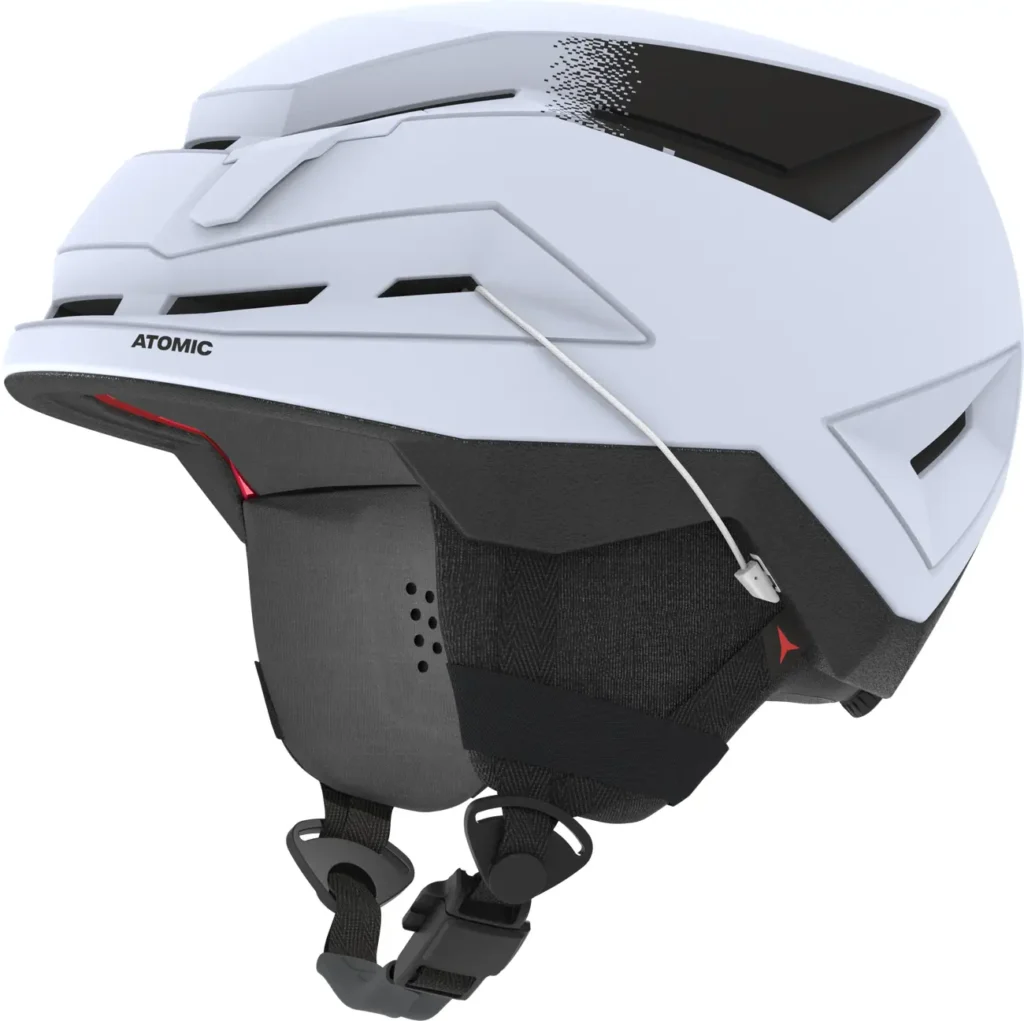
Construction: Hybrid EPP In-Mold
Shell Material: PC Microshells
Vents: –
Weight: 370g
Overall Impression: If you prefer to go beyond the resort boundaries, appreciate the latest safety innovations, and use your helmet for various outdoor pursuits, the Backland CTD is worth the investment.
The Atomic Backland CTD delivers exceptional safety, versatility, and smart technology for ski adventurers seeking a single helmet for all their pursuits. At its core, the helmet is remarkably lightweight yet incredibly protective. The Hybrid EPP In-Mold Construction seamlessly balances durability with weight efficiency, while the inclusion of both Holocore and AMID technologies.
Where the Backland CTD truly shines is its adaptability and advanced features. Shocksense technology monitors the health of your helmet, and its integrated SOS function can transmit your GPS location to emergency contacts after a severe impact. Backcountry enthusiasts rave about how reassuring these smart safety features are. The included Full Cap Ski lining and Skimo lining allow you to customize warmth levels, while the 360° Fit System guarantees a secure, comfortable fit.
The Atomic Backland CTD earns its “all-rounder” title with multi-norm certification for skiing, climbing, and cycling. This means one helmet covers you from snowy peaks to summer trails. Further thoughtful details like headlamp fixation, a removable strap station, and reflective elements elevate its functionality. The Atomic Backland CTD is indeed, an investment that will serve you across seasons and adventures.
Best Ski Helmet with Integrated Goggles
Salomon Driver Prime Sigma Photo MIPS
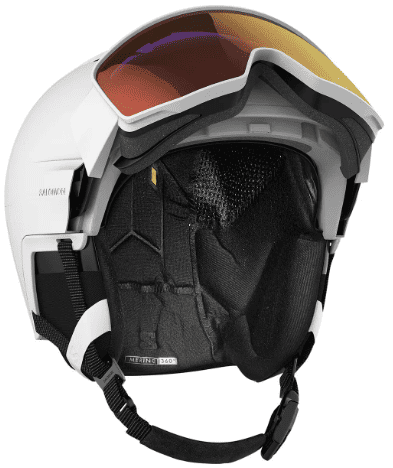
Construction: Hybrid
Shell Material: ABS
Vents: built-in active ventilation with adjustable airflow
Weight: 765g
Overall Impression: It is acclaimed for its comfort, safety, and innovative integration of a visor and helmet, but receives mixed reviews concerning visor performance in varying light conditions and difficulties in obtaining replacement lenses.
The Salomon Driver Prime Sigma Photo MIPS is a highly-rated ski and snowboarding helmet that integrates the visor and helmet into one seamless design. This model is praised for its comfort, safety features, and the Sigma Photochromic magnetic visor that offers amplified color contrast in all weather conditions. The helmet’s hybrid construction is noted for being lightweight yet strong, with MIPS technology to cater specifically to common whiplash falls. Additionally, the BOA® Fit System is highlighted for ensuring a secure fit every time you head out to the slopes.
However, users have expressed mixed feelings. While the convenience of the visor/helmet combo is appreciated, there are concerns regarding the photochromic lens’s effectiveness in different lighting conditions. Some users did not notice a significant change in visibility or tint adjustment in varying light environments. Additionally, the availability of replacement lenses seems to be a significant issue, with users finding it difficult to obtain them, even directly from Salomon. Complaints about the visor/goggle fogging up and the interior foam being thin and delicate were also mentioned, impacting comfort and usability.
Overall, while the Salomon Driver Prime Sigma Photo MIPS sets a benchmark for future helmet designs with its integrated features and safety technologies, potential buyers should consider the availability of replacement lenses and personal comfort with the helmet’s fit and visor performance
Ski Helmet Comparison Table
| Helmet | Price Range | Weight (g) | Safety Integration | Fit System | Best For |
|---|---|---|---|---|---|
| Smith Vantage MIPS | $270 | 500 | MIPS | Boa FS360 | All types, especially downhill and alpine touring |
| Giro Ratio MIPS | $120 | 610 | MIPS | In Form™ Fit System | All types, general use |
| Smith Level MIPS | $220 | 550 | MIPS, Koroyd | VaporFit | Resort skiing |
| Salomon MTN Lab | $199.95-$249.95 | 400 | Safety EPS4D | Custom dial adjustment | Backcountry Skiing, All Mountain |
| Anon Logan WaveCel | $239.95 | 424 | WaveCel | 360° BOA Fit System | General skiing with a focus on Freestyle riding |
| Atomic Backland CTD | $420 | 370 | AMID technology | 360° Fit System | Touring, Powder |
| Salomon Driver Prime Sigma Photo MIPS | $449.95 | 765 | MIPS, Smart Safety 360, EPS4D | BOA® Fit System | On-Piste |
Ski Helmet Buyer’s Guide
Sizing and fit
When it comes to ski helmets, the importance of proper sizing and fit cannot be overstated.
The foundation of a perfectly fitting ski helmet begins with accurate head measurement. Using a flexible tape measure, find the circumference of your head by wrapping the tape above your ears and an inch above the eyebrows, which are the widest parts of your head. This measurement in centimeters or inches is your starting point for selecting the right helmet size.
However, it’s important to note that helmet sizes can vary significantly across different brands. A measurement that suggests a medium in one brand might correspond to a large in another. Therefore, treat your head measurement as a guide rather than an absolute indicator of size.
Aside from that, the shape of your head is important in finding a helmet that fits correctly. Helmets are generally designed to accommodate various head shapes, from round to oval. You might find that some brands fit your head shape better than others, highlighting the importance of trying on multiple models.
Fit preferences can also vary from one individual to another. Some skiers prefer a tighter fit that ensures the helmet stays securely in place during dynamic movements, while others may prioritize a slightly looser fit for comfort reasons. The key is to find a balance — the helmet should be snug enough to remain stable on your head but not so tight as to cause discomfort or pressure points.
Check out this article from Level Nine Sports about helmet sizing guide.
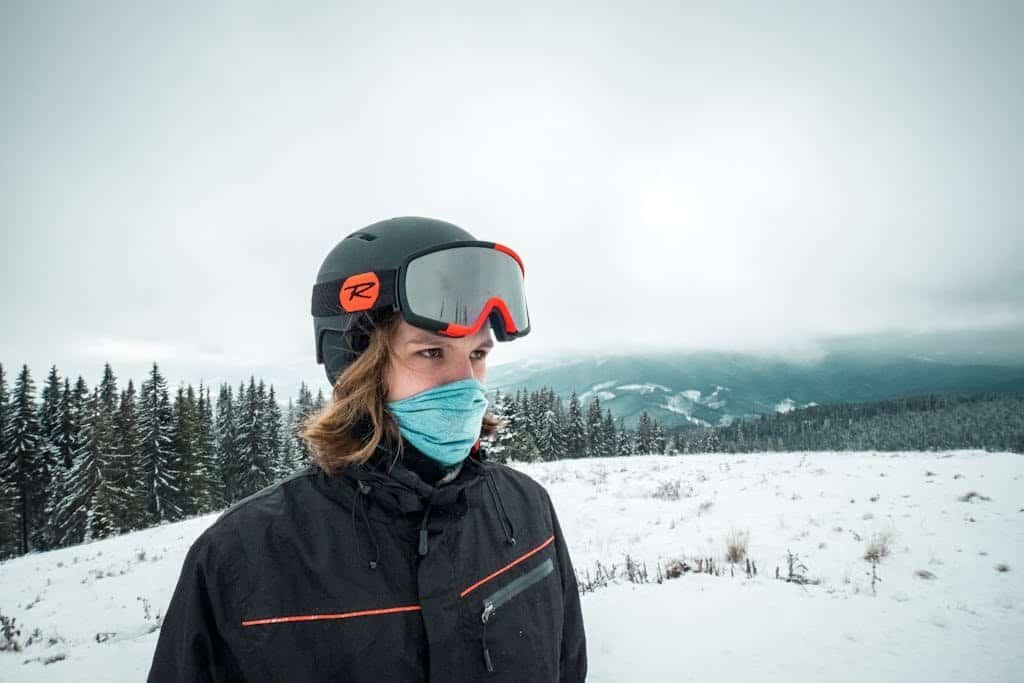
Helmet Construction Type
When you are shopping for a ski helmet, you’ll encounter terms like in-mold, hard shell, and hybrid. These terms describe how a helmet is constructed, which directly impacts its durability, weight, and how well it can absorb impacts.
In-Mold Helmets
- How They’re Made: In-mold helmets are created by bonding the outer shell and the shock-absorbing foam layer together in a single molding process. This fusion creates a strong yet lightweight helmet.
- Weight: These helmets are typically lighter than hard shell helmets, making them a comfortable option for long days on the slopes.
- Durability: While in-mold helmets are tough and can withstand impacts well, their outer shell can be more susceptible to scratches and dents from everyday use compared to hard shell helmets.
- Impact Absorption: The seamless construction helps in evenly distributing the force upon impact, providing effective protection.
Hard Shell Helmets
- How They’re Made: Hard shell helmets have a separate hard outer shell, usually made of ABS plastic, which is then glued or taped to the inner foam layer (often EPS foam). This construction method makes for a very durable helmet.
- Weight: These helmets are generally heavier than in-mold helmets due to the additional materials used. However, many find the extra weight negligible in exchange for the increased durability.
- Durability: They excel in durability. The tough outer shell can take more knocks and scratches, making it a good choice for aggressive skiers or those skiing in rugged terrain.
- Impact Absorption: Hard shell helmets are very effective at absorbing impacts. The separation between the shell and the foam layer can help to better manage the force of a collision.
Hybrid Helmets
- How They’re Made: Hybrid helmets combine elements of both in-mold and hard shell designs. They might feature an in-mold construction for most of the helmet, with hard shell materials added in strategic areas for extra protection and durability.
- Weight: These helmets aim to strike a balance between the lightweight comfort of in-mold helmets and the robustness of hard shell helmets. They’re usually in the middle range in terms of weight.
- Durability: Hybrids offer enhanced durability without as much bulk or weight as traditional hard shell helmets. They’re designed to provide the best of both worlds.
- Impact Absorption: By utilizing both construction methods, hybrid helmets are highly effective at absorbing impacts. They offer comprehensive protection by combining the benefits of even force distribution and enhanced structural integrity.
Safety Features
A key player in this domain is the MIPS (Multi-directional Impact Protection System), along with other innovative technologies aimed at reducing rotational forces on the brain during an impact.
MIPS: Multi-directional Impact Protection System
- What It Is: MIPS is a safety feature designed to protect against the rotational motion transmitted to the brain during an angled impact on the head. Rotational motion is believed to cause more severe brain injuries than direct impacts, making MIPS an essential development in helmet safety.
- How It Works: Inside an MIPS-equipped helmet, there’s a low-friction layer that allows the helmet to slide relative to the head during an impact. This movement absorbs and redirects the energy and force from the impact, potentially reducing the risk of brain injury.
- Benefits: The primary benefit of MIPS is its potential to reduce the damaging effects of rotational forces on the brain. This added layer of protection can make a significant difference in the outcome of a fall or collision.
Other Safety Technologies
While MIPS is one of the most widely recognized safety features, several other technologies also contribute to helmet safety, focusing on similar principles of impact reduction and energy absorption.
- SPIN (Shearing Pad INside): Developed by POC, SPIN technology uses silicone pad inserts that can shear in any direction, allowing the helmet to move relative to the head and reduce the force transmitted to the brain during an impact.
- WaveCel: A collapsible cellular structure that lines the inside of some helmets, WaveCel is designed to absorb both the force of direct impacts and the rotational energy, providing a comprehensive approach to head protection.
- Koroyd: This technology involves a unique honeycomb-like structure integrated into the helmet that crushes uniformly upon impact. It’s designed to absorb more energy from a crash, while also allowing for excellent ventilation.

Ventilation
There are two main types of ventilation systems in ski helmets: adjustable and fixed vents.
Adjustable Vents
- What They Are: Adjustable vents can be opened or closed by the wearer, giving you control over the airflow through your helmet.
- Why They Matter: The ability to adjust ventilation on the fly is a game-changer, especially on days when weather conditions fluctuate. Feeling too warm? Open the vents to let in cool air. Is it starting to snow, or is the temperature dropping? Close them to retain heat. This feature allows you to customize your comfort level regardless of the weather.
Fixed Vents
- What They Are: Fixed vents are, as the name suggests, non-adjustable. They’re designed to provide consistent airflow.
- Why They Matter: Helmets with fixed vents are often simpler and can be a bit lighter. They’re designed to offer a balance of warmth and ventilation that works for most conditions. While you lose the ability to control airflow, fixed-vent helmets are engineered to prevent overheating and minimize goggle fogging without any fuss.
Whether adjustable or fixed, vents are important in temperature regulation. A well-ventilated helmet helps to prevent your head from becoming too hot and sweaty, which can be uncomfortable and even lead to your goggles fogging up. Conversely, in cold conditions, closing vents can keep you warmer and more comfortable.
If you’re venturing into the backcountry, the importance of ventilation becomes even more pronounced. Backcountry skiing often involves a mix of high-exertion activities like climbing or hiking, followed by periods of rest or downhill skiing. Adjustable vents are particularly beneficial in these scenarios, as they allow you to easily regulate your temperature based on your activity level and the ambient conditions.
Liners
These liners are superstars when it comes to keeping you comfortable, warm, and even clean (yes, clean!) while you’re out playing on the slopes.
The liner in your ski helmet is what sits between your head and the hard parts of the helmet. It’s made of soft, cushy materials that feel good against your skin. Imagine putting your head on your favorite pillow after a long day—that’s what a good liner feels like, but for your head, all day long while you’re skiing.
It also helps keep your head toasty in cold weather, kind of like how a blanket keeps you warm on a chilly night. It traps heat close to your head, ensuring that even when it’s snowing or super cold outside, your head stays nice and warm. This means you can keep skiing comfortably, even when Mother Nature is turning down the temperature.
Removable Liners
Here’s where things get really interesting: removable liners. Not all helmets have them, but if you find one that does, you’re in for a treat.
- Cleaning: After a few days of skiing, your helmet can start to get a little… let’s just say, not fresh. Sweat, dirt, you name it. But with a removable liner, you can just take it out and wash it. Boom, your helmet is as fresh as new, ready for your next adventure.
- Season Adjustments: Depending on when and where you ski, you might want your helmet to be warmer or cooler. With removable liners, you can swap them out for thicker ones when it’s super cold or thinner ones when it’s a bit warmer. It’s like having a winter coat and a spring jacket but for your head.
Weight
The weight of a ski helmet is an important consideration for both comfort and safety. While specific weights can vary widely based on the design, materials, and features, most ski helmets weigh between 400 to 650 grams (approximately 14 to 23 ounces). The variance in weight is largely due to different helmet constructions:
- In-Mold Helmets: These are typically lighter, as they fuse the outer shell with the shock-absorbing foam liner, which reduces weight without compromising protection. They are favored for their lighter feel, making them comfortable for all-day use.
- Hard Shell Helmets: These are usually heavier due to the separate hard outer shell and inner foam liner. They offer robust protection and durability, often preferred by those skiing in more rugged conditions.
- Hybrid Helmets: Combining both in-mold and hard shell technologies, hybrid helmets aim to provide a balance between lightweight and enhanced protection. They can offer the best of both worlds but might lean towards the heavier side compared to pure in-mold helmets.

Goggle Compatibility
A compatible helmet and goggle combination will prevent gaps that can expose skin to cold air and snow, known as the dreaded “gaper gap.” It also minimizes the risk of the goggles being dislodged during skiing.
To ensure compatibility, many helmet manufacturers design their helmets with features that accommodate a wide range of goggle sizes and shapes. These features may include adjustable visors or brims that can be raised or lowered to fit the goggle strap, as well as ventilation systems designed to reduce goggle fogging by allowing air to flow through the helmet and goggles.
Some brands produce helmets and goggles as matched sets, designed to work together seamlessly, eliminating the guesswork for skiers. However, if you prefer to mix and match brands, it’s important to try on the helmet with the goggles you plan to use to ensure a snug, comfortable fit without any gaps or pressure points.
Many helmets come with a goggle retention clip at the back, a simple yet effective feature that helps keep the goggle strap in place, ensuring that your goggles remain secure, even during vigorous skiing activities. This compatibility not only enhances your skiing experience by ensuring clear vision and comfort but also contributes to overall safety on the mountain.
Special Features
Ski helmets today come equipped with a variety of special features aimed at improving comfort, convenience, and safety:
- Adjustable Venting: This allows skiers to control the airflow through their helmets, providing ventilation on warmer days or sealing in heat during colder conditions.
- MIPS Technology (Multi-directional Impact Protection System): Enhances protection against rotational forces on the brain caused by angled impacts. MIPS is an additional layer inside the helmet that moves slightly upon impact, offering increased safety.
- Audio Compatibility: Many helmets are now designed with built-in audio systems or earpad cutouts for aftermarket audio chips, allowing skiers to listen to music or answer phone calls without removing their helmets or gloves.
- BOA Fit System: Offers precision adjustment for a perfect fit, using a dial system to tighten or loosen the helmet around the head, ensuring it stays securely in place during active skiing.
- Removable Liners and Ear Pads: For comfort and hygiene, some helmets feature removable and washable liners and ear pads. This feature is particularly useful for skiers who frequently hit the slopes and need to clean their equipment regularly.
Maintenance and replacement
Here’s a basic guide on how to properly care for your ski helmet and recognize when it’s time for a replacement:
Keeping It Clean: After a day of carving up the mountain, your helmet deserves a little TLC. A simple mix of soap and water can do wonders, washing away the grime without damaging the helmet’s integrity. Just remember, harsh chemicals are a no-go.
Air-Dry Wisdom: Post-cleanse, let nature do its thing. Air drying away from direct heat preserves the helmet’s shape and protective features. Think of it as sunbathing, without the actual sun.
Smart Storage: Your helmet’s off-season home matters. A cool, dry spot keeps it in prime condition, ready for the first snowfall. And if you can, tuck it into a helmet bag to fend off dust and accidental drops.
A Closer Look: Regular checks for cracks, frays, or wear can spot trouble before it spots you on the mountain. Even minor damage can majorly impact protection.
Knowing When to Say Goodbye
After a Major Crash: Here’s the hard truth—if your helmet has taken a significant hit, it’s done its job, and it’s time to retire it with honors. Visible damage or not, its ability to protect has been compromised.
Wear, Tear, and Time: Helmets don’t age like fine wine. Over years, the materials degrade, even if you’ve been lucky enough to avoid crashes. Manufacturers might suggest a timeline (typically 3 to 5 years), but high use or noticeable wear can shorten that span.
Listen to the Pros: For those on the fence, guidance from organizations like the Snell Foundation can offer clarity. But remember, helmet technology evolves. Staying current means staying safe.





